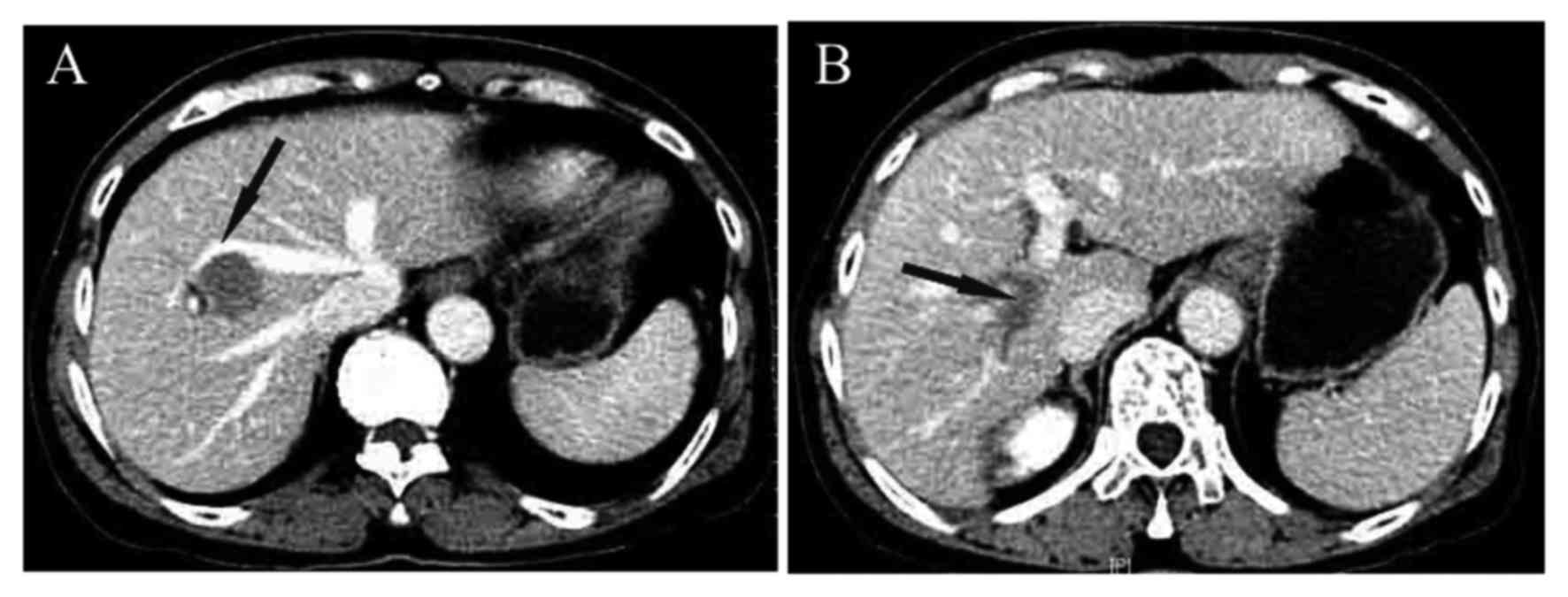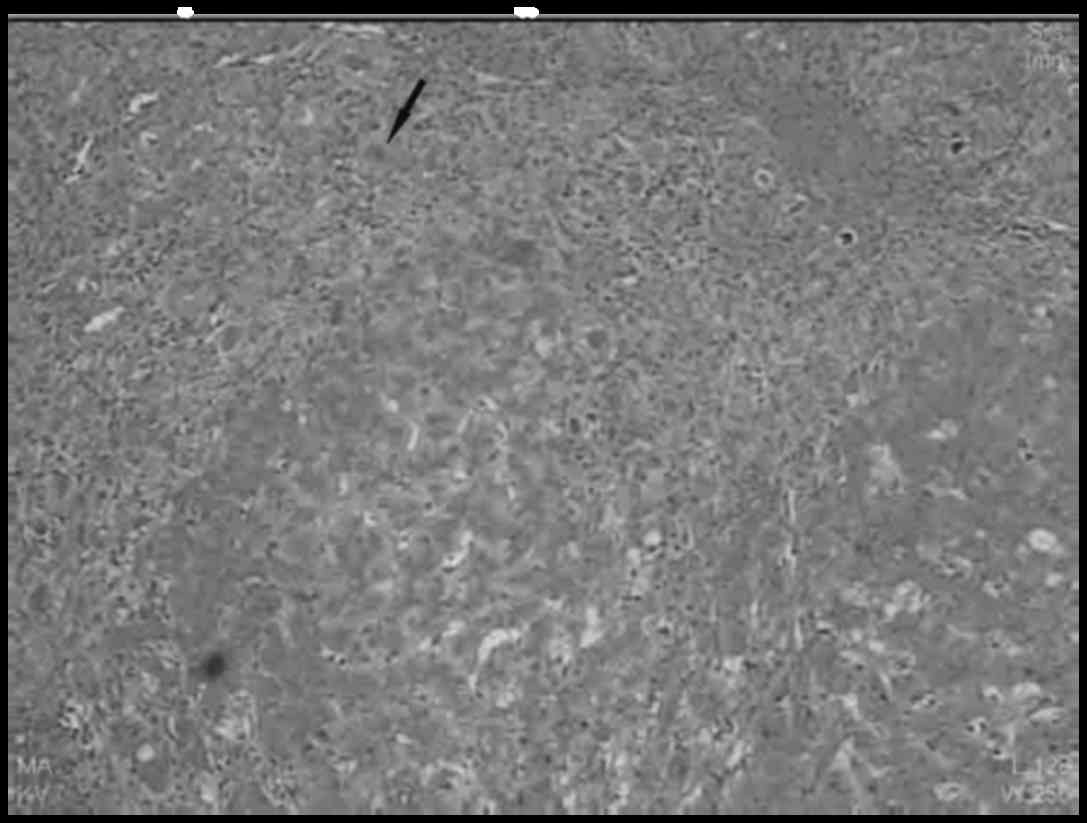Sorafenib-induced acute-on-chronic liver failure in a patient with hepatocellular carcinoma after transarterial chemoembolization and radiofrequency ablation: A case report
- Authors:
- Published online on: August 3, 2017 https://doi.org/10.3892/mco.2017.1363
- Pages: 693-695
Abstract
Introduction
Hepatocellular carcinoma (HCC) is a leading cause of cancer-related mortality worldwide and its incidence is increasing (1). The majority of patients with HCC are unsuitable for curative surgical resection. However, multimodal approaches, such as transarterial chemoembolization (TACE) and radiofrequency ablation (RFA), may be used in clinical practice. Although there are no widely accepted diagnostic criteria, acute-on-chronic liver failure (ACLF) is a newly recognized clinical entity characterized by sudden deterioration of a chronic underlying liver disease (2). Sorafenib is a multikinase inhibitor that targets both Raf and vascular endothelial growth factor and platelet-derived growth factor receptor tyrosine kinase signaling. More recently, sorafenib has come to be considered as the standard treatment for patients with advanced HCC. Liver dysfunction was reported in <1% of sorafenib-treated patients in the SHARP and Asia-Pacific trials (3,4) and only few cases of severe sorafenib-induced hepatitis have been described. We herein present the case of a patient who developed ACLF with a fatal outcome during treatment with sorafenib following TACE and RFA.
Case report
A 63-year-old woman was admitted to Lingnan Hospital (Guangzhou, China) in September, 2013 due to upper abdominal discomfort, fatigue, anorexia and a weight loss of 2 kg within 1 month. The patient has suffered from hepatitis B for 10 years without any medical treatment. Other past medical history and family history were unremarkable. Upon admission the patient was asymptomatic and there was no evidence of hepatic encephalopathy, ascites or peripheral edema. Physical examination revealed mild abdominal distention without tenderness, while the findings of the gynecological examination were normal.
The laboratory results revealed microcytic anemia (haemoglobin 9.3 g/dl, haematocrit 28%, mean corpuscular volume 63 fl). Liver tests revealed mild hypoalbuminemia (3.3 g/dl; normal, 3.5–5.5 g/dl), aspartate aminotransferase (AST) 51 U/l (normal range, 10–40 U/l) and alanine aminotransferase (ALT) 68 U/l (normal range, 7–56 U/l), whereas all other liver function tests were normal. The serum tumor markers α-fetoprotein (AFP), carbohydrate antigen (CA)19-9, CA-125, CA-153 and carcinoembryonic antigen (CEA) were all within the normal range. The following hepatitis B virus (HBV) markers were also detected: HBsAg+; HBeAg−; HBeAb+; HBcAb+; and HBV-DNA 2.84×107 copies/ml. Abdominal contrast-enhanced computed tomography (CT) revealed a 3.0×2.6-cm unifocal tumor in the V/VIII hepatic segment (Fig. 1).
As the liver lesion invaded the middle hepatic and right portal veins, the patient was unsuitable for potentially curative surgical resection. TACE was used to treat the primary cancer and, at the same time, comprehensive treatments, such as effective inhibition of HBV replication, were applied. The patient successfully recovered and was discharged 10 days after TACE. Following diagnosis with advanced incurable HCC, sorafenib was initiated the first week of October at a dosage of 400 mg twice daily. The side effects of sorafenib were generally mild, including anorexia, tinnitus, nausea and vomiting, which were well-controlled medically. One month later, a repeated CT scan of the liver indicated that the initial tumor had not completely regressed following treatment. In November, ultrasound-guided RFA was performed. The patient recovered soon and sorafenib treatment, which interrupted immediately before and after RFA, was resumed.
Seven weeks later, the patient was readmitted with abdominal pain, progressive jaundice and abdominal distension. The liver function parameters were as follows: ALT 970 U/l, AST 1166 U/l, total bilirubin/conjugated bilirubin 335/204 µmol/l, albumin 26 g/l, prothrombin time 39 sec and activated partial thromboplastin time 54 sec. HBV DNA was repeatedly undetectable and AFP remained within the normal range. These results were consistent with the diagnosed characteristics of ACLF. Liver biopsy revealed intrahepatic cholestasis, parenchymal necrosis, inflammatory infiltrates, as well as significant fibrosis, indicating both acute and chronic liver injury (Fig. 2). Although several therapies were applied, the patient succumbed to severe liver decompensation after 10 days. Written informed consent was obtained from the patient's family for the publication of the case details and associated images.
Discussion
There are multiple treatment options for HCC, including liver resection, local ablation, TACE or selective internal radiotherapy, targeted therapy with sorafenib and liver transplantation (5). The majority of the cases with HCC are diagnosed at an advanced stage and, therefore, patients cannot benefit from curative therapy. For our patient, as the primary liver tumor invading the major veins, a multidisciplinary treatment approach was applied.
TACE has become the first choice of treatment for patients with non-surgical HCC. However, the outcome in the present case was not satisfactory due to the aggressive nature of the tumor. The SHARP and Asia-Pacific trials demonstrated a significant survival benefit and good tolerance in patients with advanced HCC, making sorafenib the new reference standard for systemic therapy of patients with advanced HCC (3,4). Ineffective TACE is associated with a negative harm-benefit balance, without prolongation of the overall survival, and should not be repeated. TACE failure is an indication for sorafenib therapy in patients with advanced HCC (6). Based on these analyses, sorafenib was administered at a dose of 400 mg/bid. TACE and the specific anti-angiogenesis effect of sorafenib is one of the major strategies for a combination treatment approach. The CT scan after TACE indicated that the initial tumor did not fully regress. RFA is considered a safe and feasible procedure, with a low complication rate; thus, ultrasound-guided RFA was also applied to control tumor progression.
Hyperbilirubinemia is almost invariably present and jaundice is considered an essential criterion for the diagnosis of ACLF. In addition to jaundice, another hallmark of liver dysfunction is coagulopathy. Prolongation of the prothrombin time is common. Coagulation tests are usually abnormal in cirrhotic patients due to impaired synthesis and increased consumption of coagulation factors. In the present case, the liver function parameters revealed that the total bilirubin was 335 µmol/l and the prothrombin time was 39 sec. The clinical symptoms after hospitalization also include the development of hepatic encephalopathy, ascites and hepatorenal syndrome.
To date, the most commonly reported sorafenib-related adverse events have been diarrhea, fatigue, rash, alopecia, anorexia and nausea. The side effects in our patient were mild and effectively controlled. Liver failure was uncommon among sorafenib-treated patients in the SHARP and Asia-Pacific trials (3,4). However, Ozenne et al reported that 7 (21%) French patients with Child-Pugh A class liver disease experienced liver failure (7). In a retrospective study from Japan, Ogasawara et al also reported a higher frequency of liver failure (8): Of the 54 patients treated, liver failure occurred in 10 (19%).
ACLF is a rare syndrome with diverse etiology, which is associated with a high mortality rate (9). Although the exact pathogenesis remains to be elucidated, a number of causes may contribute to the development of ACLF. In Asia, the continuous replication and expression of HBV is considered as one of the most common acute inducers leading to ACLF (10). Another acute precipitant for ACLF is infection. Infection plays an important role in the progression and management decisions of ACLF. However, there was no evidence of HBV reactivation or specific infection after hospitalization.
The therapeutic challenge in this patient was that treatment had to be performed in a patient with an already damaged cirrhotic liver, which by itself causes significant morbidity and mortality and increases drug toxicity. Recent studies also indicated that the effectiveness of the combination of sorafenib and TACE remains questionable (11) and two recent meta-analyses reported discrepant results (12,13). However, the combination of TACE and sorafenib induced two-way targeting of vascularization through embolization and inhibition of angiogenesis. Thus, we considered that, as Ogasawara et al had reported, patients treated with sorafenib may require a dose reduction.
In conclusion, although rare, the possible development of ACLF in patients undergoing sorafenib treatment must be kept in mind. Our experience highlights that combination therapy with sorafenib should be applied with caution and patients treated with sorafenib may require a dose reduction following interventional treatment.
Acknowledgements
The present study was supported by a grant from the Science and Technology Program of Guangdong Province (no. 2014A020212715).
References
|
Gomaa AI and Waked I: Recent advances in multidisciplinary management of hepatocellular carcinoma. World J Hepatol. 7:673–687. 2015. View Article : Google Scholar : PubMed/NCBI | |
|
Jalan R, Gines P, Olson JC, Mookerjee RP, Moreau R, Garcia-Tsao G, Arroyo V and Kamath PS: Acute-on chronic liver failure. J Hepatol. 57:1336–1348. 2012. View Article : Google Scholar : PubMed/NCBI | |
|
Llovet JM, Ricci S, Mazzaferro V, Hilgard P, Gane E, Blanc JF, de Oliveira AC, Santoro A, Raoul JL, Forner A, et al: Sorafenib in advanced hepatocellular carcinoma. N Engl J Med. 359:378–390. 2008. View Article : Google Scholar : PubMed/NCBI | |
|
Cheng AL, Kang YK, Chen Z, Tsao CJ, Qin S, Kim JS, Luo R, Feng J, Ye S, Yang TS, et al: Efficacy and safety of sorafenib in patients in the Asia-Pacific region with advanced hepatocellular carcinoma: A phase III randomised, double-blind, placebo-controlled trial. Lancet Oncol. 10:25–34. 2009. View Article : Google Scholar : PubMed/NCBI | |
|
Bruix J and Sherman M: American Association for the Study of Liver Diseases: Management of hepatocellular carcinoma: An update. Hepatology. 53:1020–1022. 2011. View Article : Google Scholar : PubMed/NCBI | |
|
Arizumi T, Ueshima K, Chishina H, Kono M, Takita M, Kitai S, Inoue T, Yada N, Hagiwara S, Minami Y, et al: Validation of the criteria of transcatheter arterial chemoembolization failure or refractoriness in patients with advanced hepatocellular carcinoma proposed by the LCSGJ. Oncology. (87 Suppl 1). 32–36. 2014. View Article : Google Scholar : PubMed/NCBI | |
|
Ozenne V, Paradis V, Pernot S, Castelnau C, Vullierme MP, Bouattour M, Valla D, Farges O and Degos F: Tolerance and outcome of patients with unresectable hepatocellular carcinoma treated with sorafenib. Eur J Gastroenterol Hepatol. 22:1106–1110. 2010. View Article : Google Scholar : PubMed/NCBI | |
|
Ogasawara S, Kanai F, Obi S, Sato S, Yamaguchi T, Azemoto R, Mizumoto H, Koushima Y, Morimoto N, Hirata N, et al: Safety and tolerance of sorafenib in Japanese patients with advanced hepatocellular carcinoma. Hepatol Int. 5:850–856. 2011. View Article : Google Scholar : PubMed/NCBI | |
|
Jalan R and Williams R: Acute-on-chronic liver failure: Pathophysiological basis of therapeutic options. Blood Purif. 20:252–261. 2002. View Article : Google Scholar : PubMed/NCBI | |
|
Liu Q, Liu Z, Wang T, Wang Q, Shi X and Dao W: Characteristics of acute and sub-acute liver failure in China: Nomination, classification and interval. J Gastroenterol Hepatol. 22:2101–2106. 2007. View Article : Google Scholar : PubMed/NCBI | |
|
Kudo M, Imanaka K, Chida N, Nakachi K, Tak WY, Takayama T, Yoon JH, Hori T, Kumada H, Hayashi N, et al: Phase III study of sorafenib after transarterial chemoembolisation in Japanese and Korean patients with unresectable hepatocellular carcinoma. Eur J Cancer. 47:2117–2127. 2011. View Article : Google Scholar : PubMed/NCBI | |
|
Fu QH, Zhang Q, Bai XL, Hu QD, Su W, Chen YW, Su RG and Liang TB: Sorafenib enhances effects of transarterial chemoembolization for hepatocellular carcinoma: A systematic review and meta-analysis. J Cancer Res Clin Oncol. 140:1429–1440. 2014. View Article : Google Scholar : PubMed/NCBI | |
|
Liu L, Chen H, Wang M, Zhao Y, Cai G, Qi X and Han G: Combination therapy of sorafenib and TACE for unresectable HCC: A systematic review and meta-analysis. PLoS One. 9:e911242014. View Article : Google Scholar : PubMed/NCBI |











